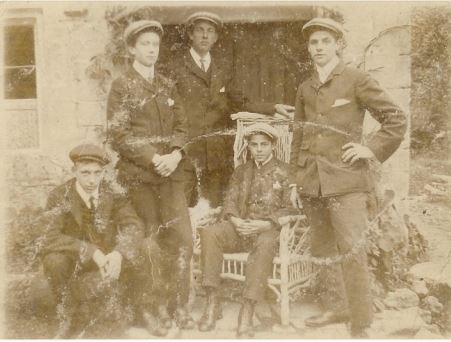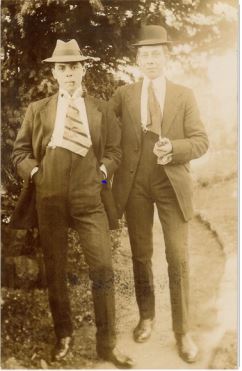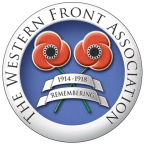1st/5th Battalion Gloucestershire Regiment

Left to right: Walter Fern, George Fern, Percy Green, Fred Gardner & Albert Painter. Photo circa 1912-1914 and most of these boys went to war.
(Albert) George Fern was born in Sheepscombe on 21 February 1892 to Elizabeth and George Fern who lived at Fern Cottage, Cockshoot. He was the youngest of five children. His siblings were Walter, Bertha, Arthur and Ernest. George was educated at Sheepscombe School and later at Painswick Boys School.
Lance Corporal George Fern died of wounds near Bray on 6 April 1917, aged 25.
The War Diary for 5 and 6 April 1917 reported that: There has been a heavy fall of snow and as it was a light night it is thought our movements to the Ry Embankment, up the Valley between the railways, was spotted by the enemy. The enemy shelled the ground in F7D immediately after the Battn. had passed. A very heavy barrage was put down by the enemy which fortunately was always just behind the rear Coy and inflicted practically no casualties.
The enemy was holding the NW end of Lempire strongly with machine guns and as became evident after the retirement of the enemy were in some strength on N edge of Lempire in small rifle pits.
The position was assaulted in very fine style by the leading Companies and a position taken up and held on NE and E side of the village by 6am, the enemy did not put up a fight at Maye Copse, though it was held. Nine prisoners were captured and 2 machine guns. a few of the enemy were killed. During the day our new positions were heavily shelled by the enemy. The attacks by 1/4 R Berks and 1/4 Oxfords met with equal success. Our casualties were 15 killed and 40 wounded (2 subsequently died of wounds).
Subsequently 1 DCM and Military Medals were given to men of the Battalion for the fight. The Battalion was relieved during the evening by the 1/1 Bucks and marched back to Villers Faucon.
Bray was a battlefield and casualty clearing centre. Captain E Conder wrote: George was wounded in the thigh and died from the effects of the wounds on the following day. The doctor who dressed him considered that the wound was not likely to be fatal, but the shock was too much for him. Your son was wounded during an attack on a village that afterwards fell into our hands. He always showed a fine example as a NCO in the leading of his men and especially in the most trying circumstances and was a great favourite among the men of his platoon. He was buried close to the hospital in which he passed away.
Lieutenant Norman Steel wrote: He was shot through the thigh by a sniper on the 6th when taking up an outpost position after a successful move forward. We all thought he had a delightful Blighty wound and four men of the platoon carried him down to the dressing station. but to the deep regret of the platoon and myself we afterwards heard that the shock had been too much and that he had passed away the same evening. I was very sorry to lose him not only because he was a section commander who knew his work thoroughly but because he was a fellow who was very popular with his platoon and with the company generally. He was always cheerful and bright and set a glorious example to his men in moments of stress. He was buried on the 8th by the RAMC.
George is buried at Bray Military Cemetery and is named on the Gloucestershire Regiment Memorial in Gloucester Park. All his brothers went to war. Walter lost an eye and Arthur was killed, leaving a widow and three young children.

Left George Fern, right Eddy Smith
